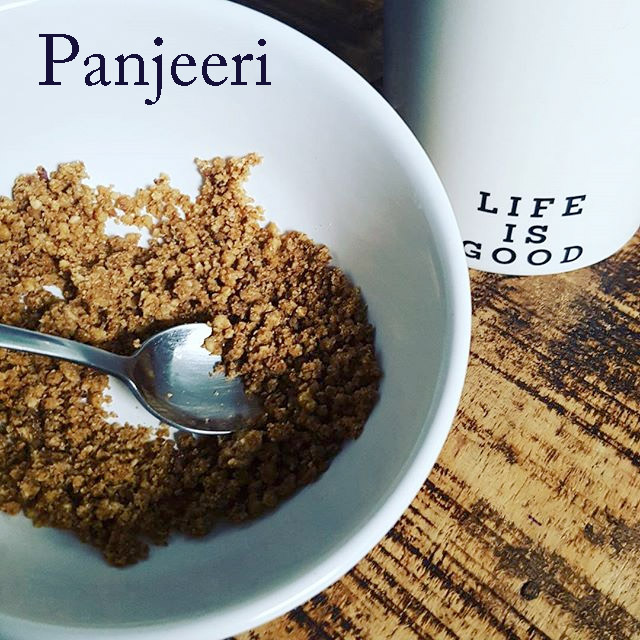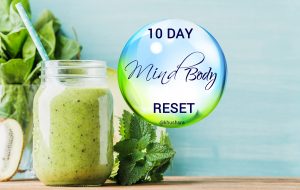When I had my daughter, just like any Indian woman, I knew panjeeri was on it’s way. The nutritionist and the mom in me was ready to eat anything to make my milk better for baby. The plus was that I loved the taste and it was going to help me recover, clear out the postpartum ‘stuff’ and be energized without having to worry about meals for herself. See panjeeri is a traditional Indian food that is known for its nutrient density and qualities. I didn’t care much before I was consuming it, but sure enough I quickly did my homework. Here is what I learned and my version of panjeeri that I still enjoy every winter(yes it can be healthy, gluten free, vegan and even paleo).
It’s a delicious treat and truly a savior many mornings, when I need something but have zero time and I swear it fuels my ambitious levels of productivity. I call it a breakfast hack for me (and the family) and clearly the generations before us did well with it too.
Panjeeri – The Basics
- Dry breakfast or afternoon snack (resembling a finely crumbed granola) eaten with cha (must have tea)
- Made with a base from flour heated in ghee, sweetened with sugar to make the bitter foods palatable
- Nuts & Seeds – in all variations, panjeeri is known for high fat content as a source of energy. Indians also believe that fat helps get the other nutrients to the needed places – and given that all our cells membranes are made of fat – this makes perfect sense (they had it together without the textbooks!)
- Superfoods & Herbs – these vary greatly depending on who is consuming and for what purpose (general snack is different than back pain and is different that post partum)
- Only a little bit at a time – usually 2-3 tablespoons is enough to satisfy one, if you eat 4-5 tablespoons your likely not hungry for a good 4 to 5 hours.
Common uses of Panjeeri
- Post-Partum: This version made for the new mother contains various herbs and foods to help cleanse post delivery, boost recovery and milk production and keep the mother fueled when she may not have time to prepare meals for herself.
- Back Injury/Physical Recovery: Given the high fat and mineral content (including calcium from the nuts) it is extremely beneficial to our bones, cartilage and muscles when we have experienced strains and sprains. Superfoods added are focused on warming the body to get blood flowing to the injured site.
- Winter Stamina: In northern India the crops are limited and the temperatures get quite low. The nutritional content of panjeeri provides the essentials of maintenance during this period, along with focusing on density when abundance is low. Warming herbs are used to help increase stamina and energy.
- Weddings & General Snacks: Panjeeri is often made during times of celebration, such as weddings, or to have as a snack. These variations have little to none of the superfoods, but are more of a treat. They do include the nuts and seeds hence remain high in fat.
Main Ingredients & Alternatives
- Flour: Stone (home) ground wheat flour, OR millet (bajri) flour, sorghum (jwar) flour, buckwheat, quinoa
- Nuts: Almonds, walnuts, cashews, pistachios
- Seeds: Char Magaz (meaning 4 seeds – commonly coming from pumpkin, cantaloupe, watermelon, cucumber), flax(alsi) AND hemp
- Sweetener: Jaggery (minimally processed cane sugar – with full mineral content), shakar – ground cane sugar, regular cane sugar OR coconut sugar
- Cooking Fat: Ghee (clarified butter), butter OR coconut oil
Superfoods & Herbs
- Kamarkas (Butea monosperma, butea Frondosa) – Bitter herb used as a muscle tonic for low back pain and pelvic/uterine muscle toning. Also has anti-depressant and anti-inflammatory properties.
- Char Gond (Gum Arabic) – Bitter herb is an astringent – reshaping, protecting the skin and also effective in reducing bleeding
- Phool Makhana (Lotus seeds) dried form – Anti-aging herb due to enzyme properties, astringent that benefits the kidneys and contains kaempferol, a natural flavonoid that’s anti-inflammatory and anti-ageing
- Methe powder (Fenugreek) ground seeds of white flowering variety – Bitter herb known to help balance hormones with oestrogen properties, balance cholesterol, warming nature and strengthens digestive processes
- Coconut – Used when headaches are involved to provide relief as this further increases fat content and provides minerals to support the endocrine and nervous systems
- Soondh (Dried ground ginger) – Warming herb that protects the immune system. Dried is different than fresh, but still carries anti-inflammatory benefits.
- Note that these are always ground before adding in. Kamarkas, Phool Makana, and Char Gond are always cooked and then ground before adding. Amount varies from 2 to 5 tablespoons, with ground ginger and methe and gum arabic being the lowest in volume.
How to make winter stamina panjeeri
Ingredients:
- 2.5 cups sorghum flour
- 1.5 cups qunioa or buckwheat flour
- 1.5 cups organic grass fed ghee
- 0.5 cups + 2 tablespoons coconut sugar (to taste & to balance bitter)
- 1 cup almonds (finely chopped)
- 1 cup walnuts(finely chopped)
- 1 cup cashews(finely chopped)
- 0.5 cup pumpkin seeds(finely chopped)
- 1 cup char magaz (melon seeds)(finely chopped)
- 3 tablespoons ground flax seeds
- 0.5 cup tablespoons ground methe (add slowly and check bitterness)
- 4 tablespoons kamarkas (fried in 1 tablespoon ghee on the side, cooled and ground)
- I like to add ashwaganda and hemp seeds (optional at end)
Directions:
- Get the ingredients and chopper out to be effective with your time you can chop during the time the flour is cooking.
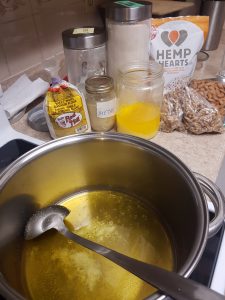
- Heat the ghee or coconut oil in a large, wide pot on medium heat until warm
- Add in the flour and stir frequently for about 15-20 minutes until the flour to just brown and release oils
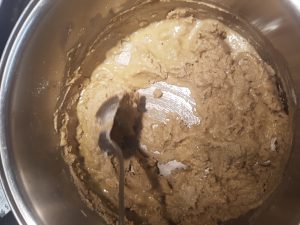
- Add in the coconut sugar. Flour will resemble a thick paste or soft cookie batter
- Remove from heat and set aside
- Chop the nuts and seeds. Leave a bit coarse and avoid grinding into a nut butter. Set aside
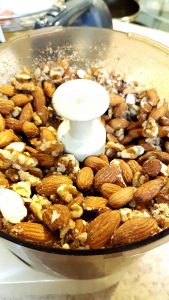
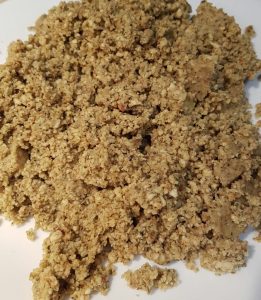
- Fry the kamarkas on medium for approximately 10 minutes and cool before grinding – this may require a coffee grinder for a fine grind.
- Measure out the flax seeds, methe, hemp, and other desired herbs ( I added ashwaganda)
- Be sure to let the base cool down before you add in the nuts and seeds.
- Fold in all remaining ingredients in the large pot with the base.
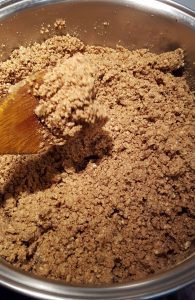
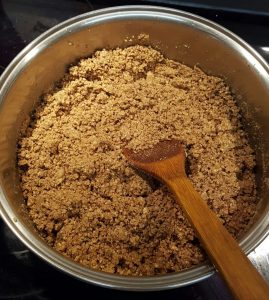
- Test the sweet/bitter of the panjeeri and adjust by adding in additional sugar if needed
- Let cool and store in glass containers for up to 2 months in cool area.
- Make some cha and enjoy a few spoons each morning, I like mine very slightly warmed up
- Wishing you easy breakfasts and productive days
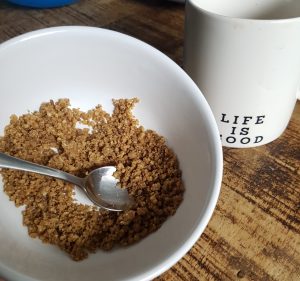
Sign up for updates and recipes on Nutrition and Mindfulness from Khush
